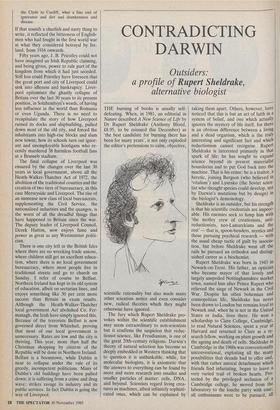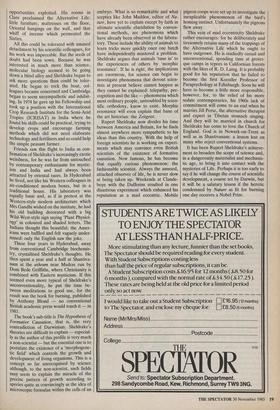CONTRADICTING DARWIN
Outsiders:
a profile of Rupert Sheldrake,
alternative biologist
THE burning of books is usually self- defeating. When, in 1981, an editorial in Nature described A New Science of Life by Dr Rupert Sheldrake (Anthony Blond, £8.95, to be reissued this December) as 'the best candidate for burning there has been for many years', it not only exploded the editor's pretensions to calm, objective, scientific rationality but also made many other scientists notice and even consider new, radical theories which they might otherwise have ignored.
The fury which Rupert Sheldrake pro- vokes within the scientific establishment may seem extraordinary to non-scientists but it confirms the suspicion that reduc- tionist science, like Freudianism, is one of the great 20th-century religions. Darwin's theory of natural selection has become so deeply embedded in Western thinking that to question it is unthinkable, while, for molecular biologists, it is axiomatic that the answers to everything can be found by more and more research into smaller and smaller particles of matter: cells, DNA, and beyond. Scientists regard living crea- tures as machines, albeit infinitely sophisti- cated ones, which can be explained by taking them apart. Others, however, have noticed that this is but an act of faith in a system of belief, and one which actuallY ignores the mystery of life itself, for there is an obvious difference between a living and a dead organism, which is the trolY interesting and significant fact and which reductionism cannot recognise. Rupert Sheldrake is interested primarily in that spark of life; he has sought to expand science beyond its present materialist boundaries and to put God back into the machine. That is his crime: he is a traitor,.a heretic, joining Bergson (who believed in 'vitalism') and Lysenko (the Soviet scien- tist who thought species could develop, not by Darwin's mutations but by design) in the biologist's demonology. Sheldrake is an outsider, but his strength is that his scientific credentials are impecc- able. His enemies seek to lump him with 'the motley crew of creationists, anti- reductionists, neo-Lamarckians and the rest' — that is, spoon-benders, mystics and those pursuing psychical research — with the usual cheap tactic of guilt by associa- tion, but before Sheldrake went off the rails he pursued an orthodox and disting- uished career as a biochemist.
Rupert Sheldrake was born in 1943 in Newark-on-Trent. His father, an optician who became mayor of that lovely and largely unspoiled Nottinghamshire market town, named him after Prince Rupert who relieved the siege of Newark in the Civil War. Despite his often bohemian and cosmopolitan life, Sheldrake has never been drawn to London but remains loyal to Newark and, when he is not in the United States or India, lives there. He won a scholarship to Clare College, Cambridge, to read Natural Sciences, spent a year at Harvard and returned to Clare as a re- search fellow, working on plant growth and the ageing and death of cells. Sheldrake ill Cambridge in the 1960s was conventionally unconventional, exploiting all the manY possibilities that decade had to offer and, with that rather amoral detachment which friends find infuriating, began to leave a very varied trail of broken hearts. Pro- tected by the privileged seclusion of a Cambridge college, he moved from the laboratory to the louche party with ease; all enthusiasms were to be pursued, all Opportunities exploited. His rooms in Clare proclaimed the Alternative Life: little furniture, mattresses on the floor, Oriental hangings on the wall, and that whiff of incense which permeated the Sixties.
All this could be tolerated with amused detachment by his scientific colleagues, for his work was impeccable. But the seeds of doubt had been sown. Because he was interested in much more than science, molecular biology seemed to be going down a blind alley and Sheldrake began to ask more questions than could be toler- ated. He began to rock the boat, col- leagues became concerned and Cambridge began to seem unsympathetic and inhibit- ing. In 1974 he gave up his Fellowship and took up a position with the International Crop Research Institute for the Semi-Arid Tropics (ICRISAT) in India where he found his skills could be practical, trying to develop crops and encourage farming methods which did not need elaborate technology and fertilisers and so could help the simple peasant farmer.
Friends saw this flight to India as con- firmation of Sheldrake's increasingly exotic weirdness, for he was far from untouched by contemporary enthusiasms for mystic- ism and India and had always been attracted by oriental races. In Hyderabad he lived, not like his Western colleagues in air-conditioned modern boxes, but in a traditional house. His laboratory was equally basic and, as if in protest at the Western-style modern architecture which Mrs Gandhi wished on the institute, he had his old building decorated with a big Wild-West-style sign saying 'Plant Physiol- ogy' in coloured and shaded letters. The Indians thought this beautiful; the Amer- icans were baffled and felt vaguely under- mined: only the English saw the joke.
These four years in Hyderabad, away from conventional Cambridge biochemis- try, crystallised Sheldrake's thoughts. He then spent a year and a half at Shantiva- nam at the ashram near Madras run by Dom Bede Griffiths, where Christianity is combined with Eastern mysticism. If this seemed even more typical of Sheidrake's unconventionality, he put the time be- tween meditations to good use, for the result was the book for burning, published by Anthony Blond — no conventional British academic press would touch it — in 1981.
The book's sub-title is The Hypothesis of Formative Causation, that is, the very contradiction of Darwinism. Sheldrake's theories are difficult to explain — especial- ly as the author of this profile is very much a non-scientist — but the essential one is to postulate the existence of a `morphogene- tic field' which controls the growth and development of living organisms. This is a concept so far unrecognised by science although, to the non-scientist, such fields may seem to explain the miracle of the precise pattern of growth according to species quite as convincingly as the idea of microscopic formulae within the cells of an embryo. What is so remarkable and what sceptics like John Maddox, editor of Na- ture, have yet to explain except by faith in ultimate scientific elucidation by conven- tional methods, are phenomena which have already been observed in the labora- tory. These include the ability of animals to learn tricks more quickly once one batch have independently mastered a problem. Sheldrake argues that animals 'tune in' to the experiences of others by 'morphic resonance'. If he is right, the implications are enormous, for science can begin to investigate phenomena that devout scien- tists at present believe cannot happen as they cannot be explained: telepathy, pre- cognition and the like — phenomena which most ordinary people, untroubled by scien- tific orthodoxy, know to exist. Morphic resonance will even explain that bane of the art historian: the Zeitgeist.
Rupert Sheldrake now divides his time between America and Britain, for he finds almost anywhere more sympathetic to his ideas than this country. With the help of foreign scientists he is working on experi- ments which may convince even British scientists of the existence of formative causation. Now famous, he has become that equally curious phenomenon: the fashionable scientist. Always the amused, attached observer of life, he is never slow at being taken up. Weekends at Claude- boye with the Dufferins resulted in one disastrous experiment which enhanced his reputation as a mad eccentric. Mobile pigeon coops were set up to investigate the inexplicable phenomenon of the bird's homing instinct. Unfortunately the pigeons flew away.
This vein of mad eccentricity Sheldrake rather encourages: for he deliberately and tiresomely retains many of the trappings of the Alternative Life which he ought to have outgrown. He is studiedly casual and unconventional, spending time at grotes- que camps in tepees in Californian forests with the likes of R. D. Laing. It is probably good for his reputation that he failed to become the first Koestler Professor of Parapsychology at Edinburgh. Soon he will have to become a little more responsible, however, for, to the relief of his more sedate contemporaries, his 1960s lack of commitment will come to an end when he marries Jill Perse, the alternative therapist and expert in Tibetan stomach singing. And they will be married in church for Sheldrake has come to love the Church of England. God is in Newark-on-Trent as well as in Shantivanam: a lesson lost on many Who reject conventional systems.
It has been Rupert Sheidrake's achieve- ment to broaden the scope of science and, in a dangerously materialist and mechanis- tic age, to bring it into contact with the mysteries of Life. Perhaps it is too early to say if he will change the course of scientific development, a course set by Darwin, but it will be a salutary lesson if the heretic condemned by Nature as fit for burning one day receives a Nobel Prize.



























































 Previous page
Previous page